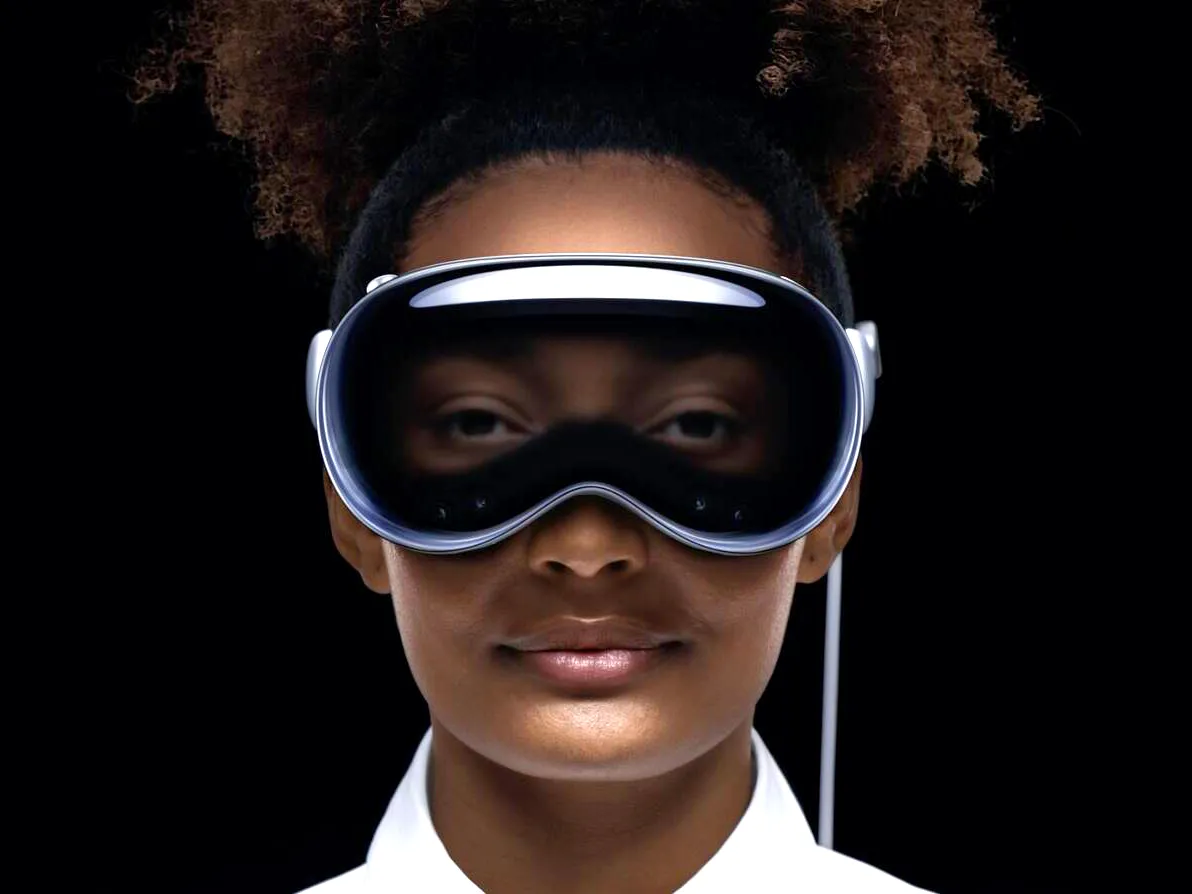Apple Vision Pro Headset Unveiled at WWDC23

Apple doesn’t launch new products often and this is a big one. The Apple Vision Pro headset debuted today at WWDC23.
It has a custom aluminum alloy frame that curves around the user’s face. Its modular design means the Light Seal can fit each individual user perfectly. It runs visionOS which is designed from the ground up for visual computing.
What is the Apple Vision Pro?
Apple has a new headset that will allow users to watch 3D videos and take panoramic pictures. The Apple Vision Pro is a headset that uses a passthrough video camera to allow users to view the world around them in virtual reality. The headset is similar to previous VR and AR headsets from Sony, Microsoft, HTC and others.
The headset features two Micro OLED 4K displays, one for each eye. The company says the display has 23 million pixels, or six times the pixel density of an iPhone. The displays are paired with a new R1 chip that can process input from the headset’s dozen cameras and sensors. It is designed to eliminate lag and update images eight times faster than the blink of an eye, according to Apple.
A custom aluminum alloy frame sculpted to fit each wearer’s head is attached to the headset. The frame is rounded to better accommodate the contours of the human face. The device has a woven cable that connects the headset to an external battery pack. Apple says that the battery pack can be used to power the headset for up to two hours of continuous use.
Scott Stein at CNET was impressed with the Apple Vision Pro and praised its immersive experience. He compared the visual quality of the headset to the Varjo XR-3 and said it felt like a cinematic experience. The headset also allows for a contextual “EyeSight” feature that reveals your eyes to people around you so that they know you’re not ignoring them.
Unlike many VR and AR headsets, the Apple Vision Pro does not require a dedicated smartphone to run its apps. The headset will work with iOS and macOS, and Apple will release a free companion app that will let users download experiences. The app will also let users transfer content from their iPhone or iPad into the headset.
The Apple Vision Pro is priced starting at $3,499 and will be available in the U.S. in early 2024. The price tag may seem astronomical but the headset probably costs a fortune to produce. It likely includes a new M2 and R1 processor as well as a dozen cameras, sensors and other components.
How does the Apple Vision Pro work?
Apple’s Vision Pro headset is built on a single piece of 3D-formed laminated glass that curves to fit the wearer’s head. It’s connected to an aluminum alloy frame that hugs the head with a soft fabric called Light Seal. The headset is powered by an external battery pack that connects around the temple via a woven cable.
Inside, the headset uses two internal displays (one for each eye) to display virtual images. To do so, Apple’s new R1 chip is used to process information from 12 cameras, five sensors and six microphones. Apple says this new chip eliminates lag to make content feel like it’s appearing right in front of the user’s eyes.
The Vision Pro also has an array of downward-firing exterior cameras that track the user’s hands, allowing them to interact with the virtual world through hand gestures. This feature isn’t available in all VR headsets and it could be a big selling point for the Vision Pro.
One of the most interesting features about the Vision Pro is its ability to switch between VR and augmented reality experiences. Apple’s demonstrations of the device leaned heavily towards AR, with the headset displaying people who approach the wearer in the real world. The headset’s front display can even display the wearer’s own eyes to let people know they can’t see them and are busy.
Another feature is that the headset can show what it’s capturing through its lenses in real time. Apple describes this as an “everywhere display” that makes it easy to see and share the world of VR with others.
For glasses wearers, Apple has worked with ZEISS to develop optical inserts that magnetically attach to the headset’s lenses. Apple says these will correct most prescriptions and they can be swapped out easily if needed. The company hasn’t announced pricing for these accessories. The Vision Pro will also work for users who need hearing aids, and Apple has partnered with Braille International to provide audio content that can be read on the device. The headset can be paired with an iPhone or iPad to control apps and media, and Apple has integrated support for Siri.
Is the Apple Vision Pro comfortable?
The Apple Vision Pro headset, unveiled at the Worldwide Developers Conference on Monday, looks impressive. Designed to work with iPhone and iPad apps, the headset lets you play games, watch movies, take spatial photos and video, and get more productive with your Mac. The headset uses a combination of eye and hand tracking, as well as voice control, to let you move around in a virtual space without the need for additional controllers.
Tech YouTuber Marquee Brownlee got his hands on the headset and was very impressed with its performance. He said that it was easy to navigate, and that the headset is more comfortable than most he has tried before. He was also able to make FaceTime calls and use apps on his Mac without having to remove the headset. The headset can even project the screen of a MacBook laptop onto a virtual display when you look at it.
However, the $3499 price tag remains a sticking point. Brownlee also said that the headset’s design is a little on the bulky side, so it may not be suitable for extended wear. The headset’s frame is made from aluminum alloy and is curved to fit your head, and it comes with different size Light Seals (what Meta calls a facial interface) for a custom fit.
Apple’s Vision Pro headset also includes a pair of high-resolution micro OLED displays with 23 million pixels, which is more than a 4K TV for each eye. It can track your gaze with a ring of LEDs and invisible sensors, and it eliminates lag to keep up with your movements so that images appear as if they are happening in real time. The headset will also support the new iPhone XS and iPhone XR, so you can use it to watch movies, sports games, and other apps on those devices.
The Vision Pro will also allow you to view panoramic images that you have created on your iPhone or iPad, and it will also display photos and videos in 3D. It can even dim the surrounding environment so that you can watch a movie in VR like you are in a theater.
Is the Apple Vision Pro easy to use?
Apple describes the headset as a “mixed reality experience” that combines augmented reality with virtual reality. It uses a front display to show the world around you and sensors inside the headset that track your movements. It can also capture 3D visual files that you can later view on a Mac or iPhone. These aren’t 3D files in the traditional sense where you can walk into them, but more like stereoscopic photos or videos that give the illusion of depth.
The headset is controlled mainly by your eyes, hands and voice. You can look at apps to scroll through them, tap your fingers to select them and use the built-in mic to voice-control functions. It also works with Bluetooth accessories like a mouse and keyboard for more precise control. You can even connect it to your Mac and see a 4K display on the headset, making it a portable, private work station.
You can watch 4K movies, play games and use other augmented reality apps that are designed for Apple’s headset. The headset is compatible with a wide range of popular games controllers and has built-in audio pods that can deliver spatial audio on supported services, eliminating the need for external earbuds. A knob on the back-left of the headset adjusts the amount of tension holding the headband in place, so you can find a comfortable fit.
For those who wear glasses, Apple has worked with ZEISS to make optical inserts that can replace your lenses while you’re using Vision Pro. It’s unclear how much these will cost or whether they affect the fidelity of the headset, but Apple is keen to avoid people having to choose between wearing glasses and using its VR headset.
The headset is tethered, though you can also choose to power it wirelessly with the included battery or your Mac. The battery will be tucked away in the body of the headset to reduce its weight and size, but it won’t let you use it for more than two hours at a time. Apple says you can use a tethered cable with the headset when connected to your computer for longer sessions.
